
Online collections
monedastodas.com
All collections » Tokens » "Barbados
The first known evidence of settlers on
the island of Barbados dates back to 350 AD. They were a group of
Barrancoid Saladoids, indigenous people of Venezuela, who came to the island by
canoe from the Orinoco River valley. They were engaged in
agriculture, fishing and pottery making. Later, around 800 AD,
Indians from the Arawak tribe sailed to the island from South America. According
to surviving records, the island was originally called Ichirouganaim.
In the 13th century, the island was
settled by the Indians of the Carib tribe, displacing both previous ones from
it.
In 1536, the Portuguese explorer Pedro
Campos arrived on the island, and, seeing an abundance of fig trees growing on
it, entwined with beard-like epiphytes, he named the island Os Barbados
("bearded"). Spanish conquistadors raided the island from 1536 to
1550 to capture the Caribs as slaves.
In 1605, the crew of the Olive Blossom
claimed the island as an English possession. The British sailor
John Powell, returning from Brazil in 1624, again proclaimed it the possession
of the King of England. In 1625, the London merchant William
Curtin, acting under the auspices of Lord Marlborough, to whom King James I
granted Barbados, equipped two ships and sent them to the island. One
of these ships reached Barbados and landed on its leeward side about 30 settlers
who founded the village of Jamestown, of which Captain William Dean (1625–1628)
became the first governor.
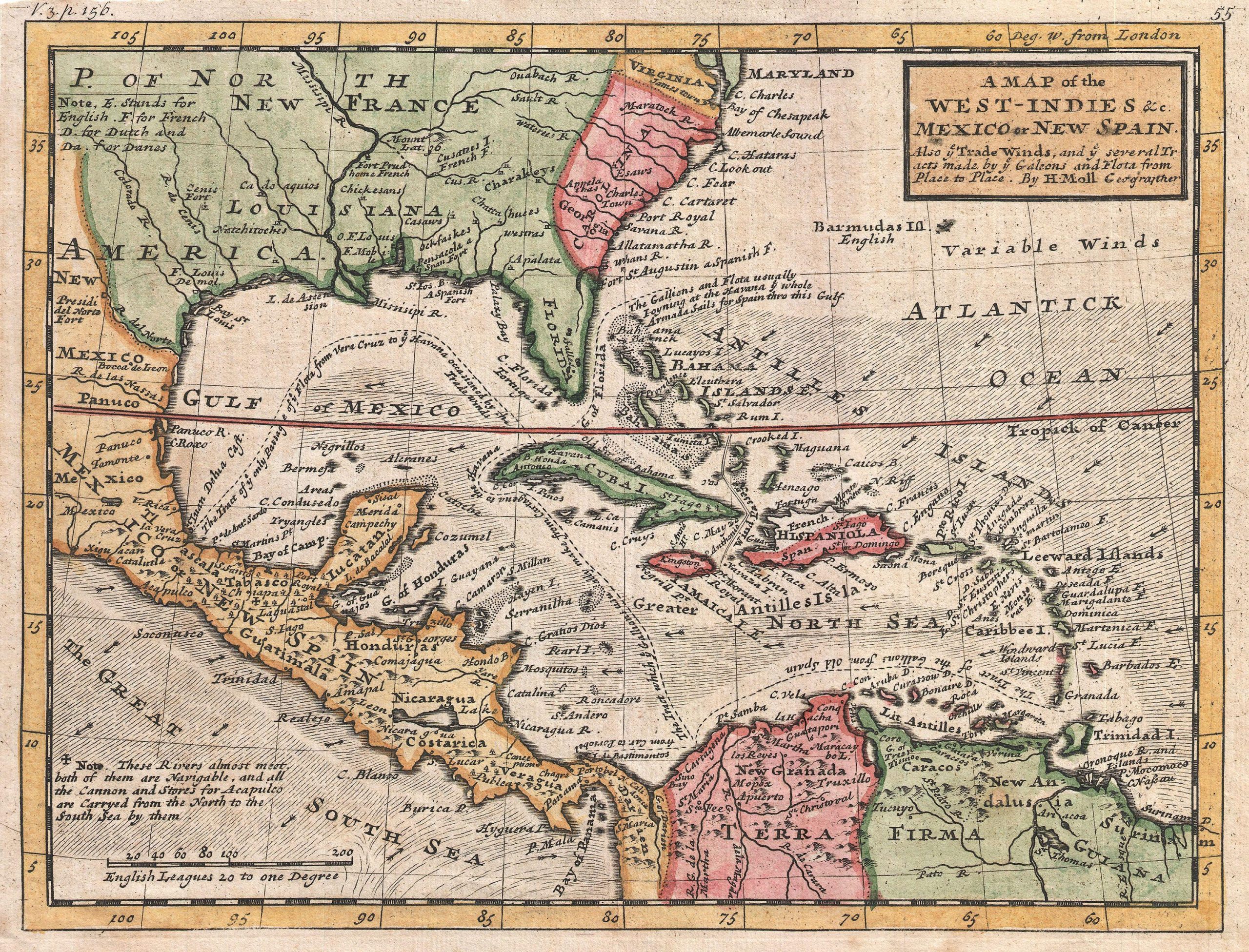 Map
of the West Indies and the Caribbean from 1732.
Map
of the West Indies and the Caribbean from 1732.In 1627, King Charles I of England presented the Caribbean Islands to the Earl of Carlisle. Lord Marlborough protested, but eventually recognized the rights of the rival in exchange for an annuity of 300 pounds. However, soon the Earl of Carlisle was entrusted with a diplomatic mission, and the royal patent was transferred to the Earl of Pembroke, and then to the Lord Chamberlain, who continued to support the initiative of William Curtin to settle the island.
After the end of the diplomatic mission, the Earl of Carlisle obtained from the king confirmation of his authority over the island and sent a group to Barbados, led by a native of Bermuda, Charles Wolferston. In 1628, sixty-four settlers landed in Carlisle Bay on the windward side of Barbados, built wooden houses, built a bridge across the river, and thus laid the foundation for Bridgetown, the current capital of the island. Wolferston served as governor from 1628–1629. Already 1850 people lived on the island at that time. The first settlers were engaged in the cultivation of tobacco, cotton, indigo, pepper, citrus fruits, as well as animal husbandry. By 1636, the population reached 6 thousand people.
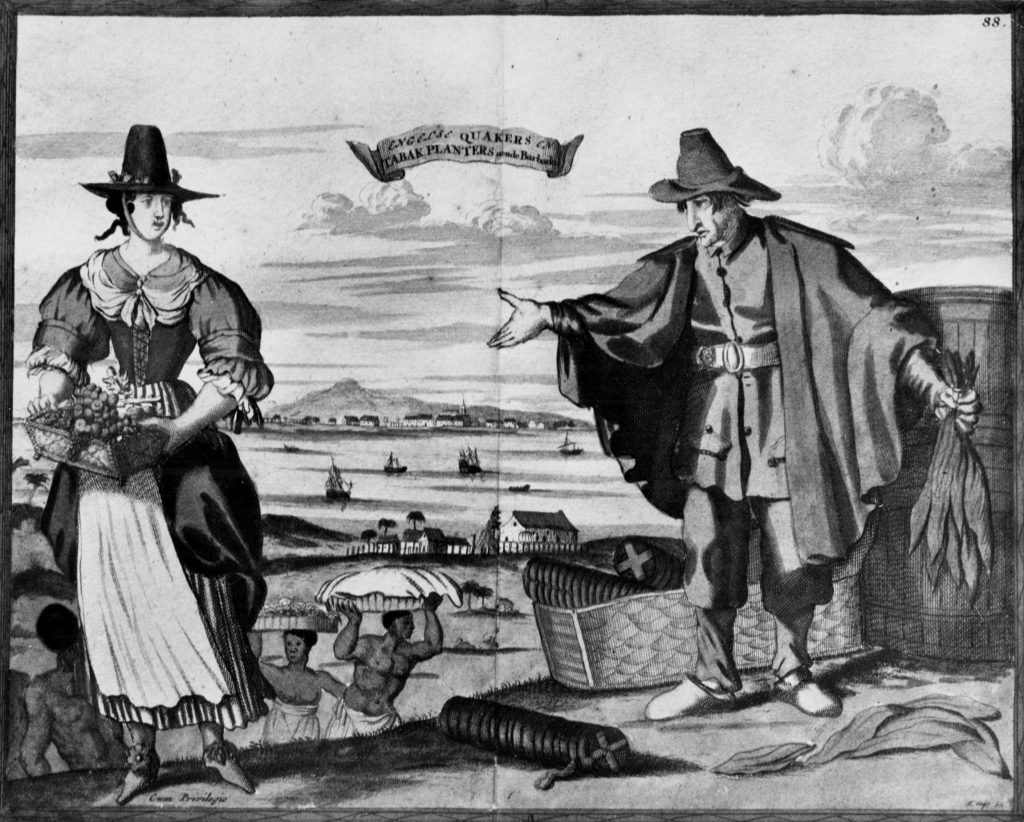 Engelse
Quakers en Tabak Planters aende Barbados.
Engelse
Quakers en Tabak Planters aende Barbados.In 1637, a self-governing body was created in Barbados - the House of Assembly (the second parliament in British possessions after Great Britain itself), but only a small part of the population received voting rights. The English Revolution led to a sharp increase in the population of the island. In 1643, 37 thousand people already lived on it - many of them arrived here fleeing the persecution of political opponents, or as a result of exile. After the overthrow of King Charles I, many royalists took refuge in Barbados. In 1650, Lord Carlisle (son of the Earl of Carlisle) gave the island to the royalist Lord Francis Willoughby (1650–1651).
In 1652, Barbados formally passed to the English Republic and was governed by an appointed governor, and Willoughby was expelled. The island turned into an impregnable fortress - along the entire coast there were 26 forts armed with formidable artillery. The metropolitan government issued the Charter of Barbados, according to which power on the island belonged to the governor, the council and a freely elected assembly. England pledged not to impose taxes without the consent of the islanders. After the restoration of the monarchy in England in 1662, Lord Willoughby renewed his claim. The British crown decided to annex Barbados in exchange for imposing a 4.5% duty on all exports. This fee was supposed to go to the benefit of the former owners of the island.
Initially, the main crop that the English
settlers began to grow was tobacco, but its production turned out to be
unprofitable. In 1640, sugar cane was introduced to Barbados, which
became the basis of the island's economy. Large agricultural
plantations arose, requiring a large number of laborers. Since
there were few people willing to work in the colony, coercion and direct deceit
were often used to recruit workers in England. The recruiters who
fell into debt bondage offered to pay the fare and, after working out on the
plantation and covering all debts, to provide a piece of land for their own
farm. But after their arrival, they were turned into serfs, and the
recruits could not return home due to lack of funds. There were
cases of kidnapping people to work in the West Indies.
Having subjugated Ireland, Oliver
Cromwell sent about 12,000 shackled Irish to the sugar plantations of Barbados
and Jamaica. During the time of the English king James II Stuart,
about 30,000 Irish prisoners were sent to the West Indies.
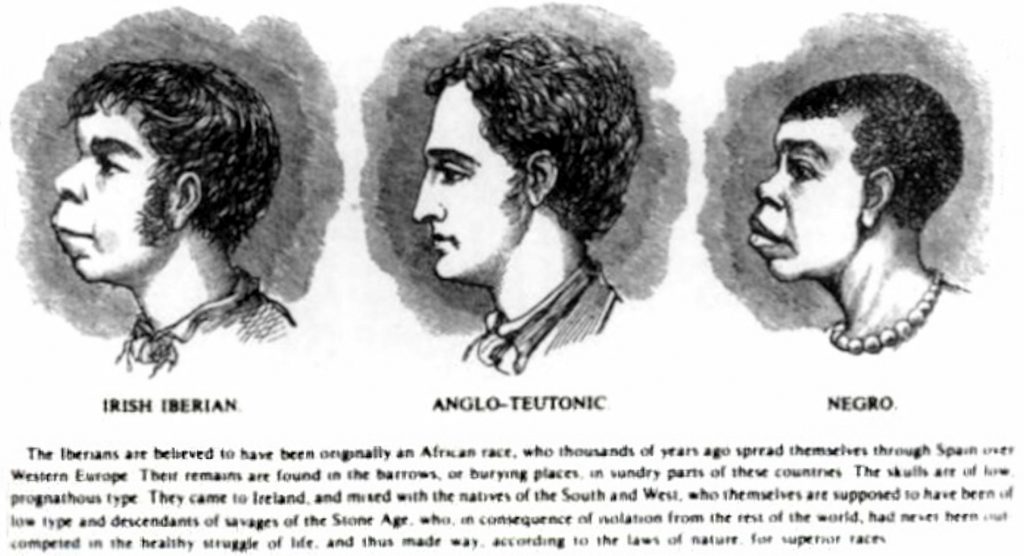 Illustrated
pamphlets explained to an enlightened public that the Irish were intermediate
between whites and blacks. From the English magazine Harper's
Weekly, 1899: "The Iberians are supposed to have originally belonged to the
African race, which spread thousands of years ago through Spain into Western
Europe. Their remains are found in mounds or burial places in
various parts of these countries. Skulls with a low protruding jaw. They
came to Ireland and mingled with the natives in the West and South, who
themselves were probably an inferior race and descended from the savages of the
Stone Age, who, as a result of isolation from the rest of the world, were never
forced out in a healthy struggle for life, and thus, according to the laws of
nature, made room for the higher races."
Illustrated
pamphlets explained to an enlightened public that the Irish were intermediate
between whites and blacks. From the English magazine Harper's
Weekly, 1899: "The Iberians are supposed to have originally belonged to the
African race, which spread thousands of years ago through Spain into Western
Europe. Their remains are found in mounds or burial places in
various parts of these countries. Skulls with a low protruding jaw. They
came to Ireland and mingled with the natives in the West and South, who
themselves were probably an inferior race and descended from the savages of the
Stone Age, who, as a result of isolation from the rest of the world, were never
forced out in a healthy struggle for life, and thus, according to the laws of
nature, made room for the higher races."Then, black slaves from West Africa began to be imported to the island in large quantities. If in 1645 there were 11,200 small European farmers in Barbados, who used the labor of 5,680 slaves, then in 1670 the land was in the hands of 745 planters, who had more than 82,000 black slaves. By 1680, about 7% of landowners (175 people) owned 54% of all real and movable property. A powerful and privileged stratum of the plantation aristocracy was formed. The small farms of the first European settlers went bankrupt, and their owners either returned to England or joined the ranks of the “poor whites”. From 1670 to 1724 the white population dropped from 70,000 to 18,000. The share of the involuntary black population was 81%.
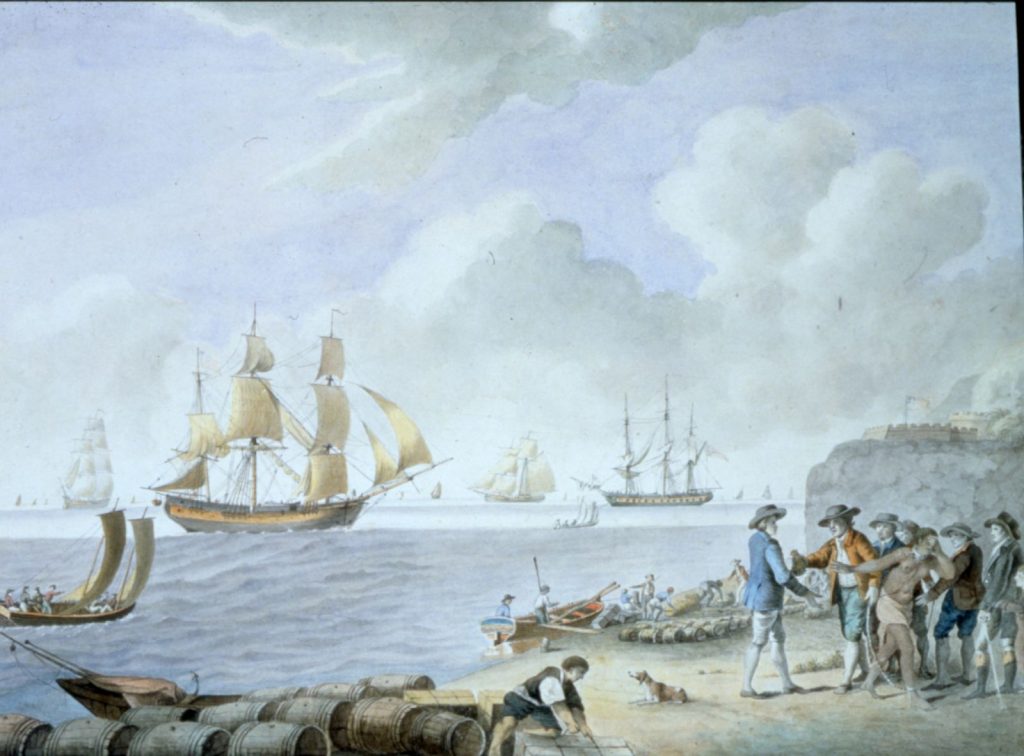 Slave
Traffic, Samuel Hutchinson, 1793.
Slave
Traffic, Samuel Hutchinson, 1793.
Often, Europeans did not make Africans
slaves themselves - they bought them from other Africans. The
growing demand for black slaves drove up prices and created a situation of
intense competition between tribes in West Africa, in which the capture of
people became not a side effect, but the main cause of wars.
The slaves who fell into the holds of
ships had never seen white people before and had not encountered such cruelty
and inhumanity. From horror they starved themselves, but they were
force-fed. The voyage lasted six to eight weeks. If
every sixth person died along the way, it was considered a good flight. If
every third was bad, you had to argue with the insurance company, because slaves
were insured like any other product.
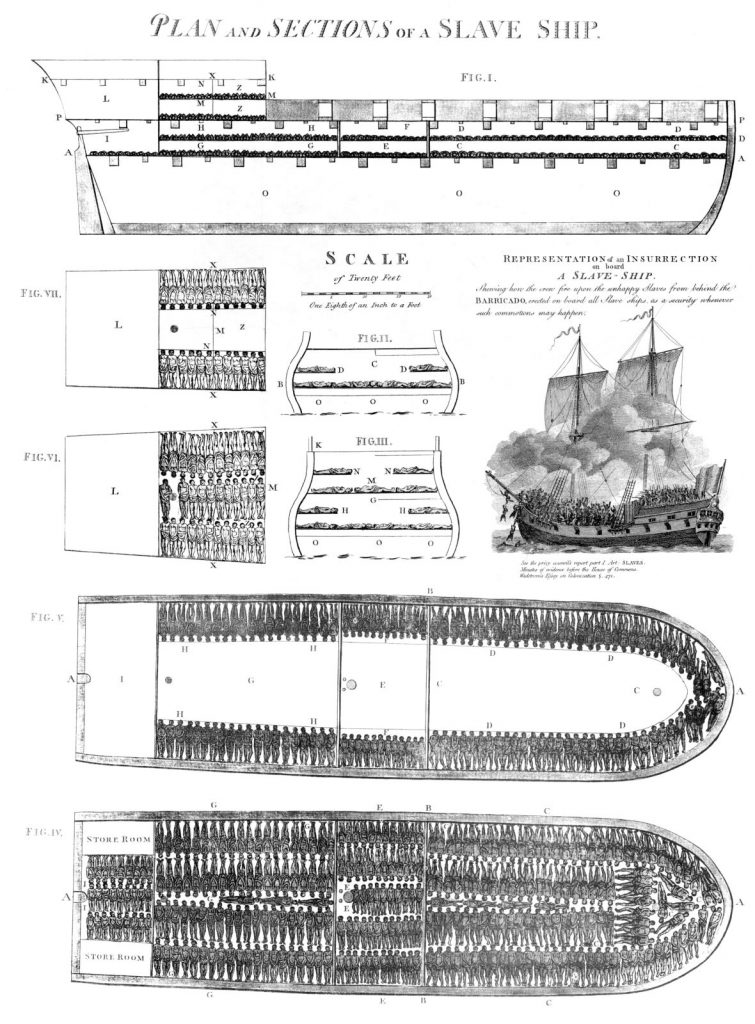 Plan
of the British Slave Ship Brookes, 1789
Plan
of the British Slave Ship Brookes, 1789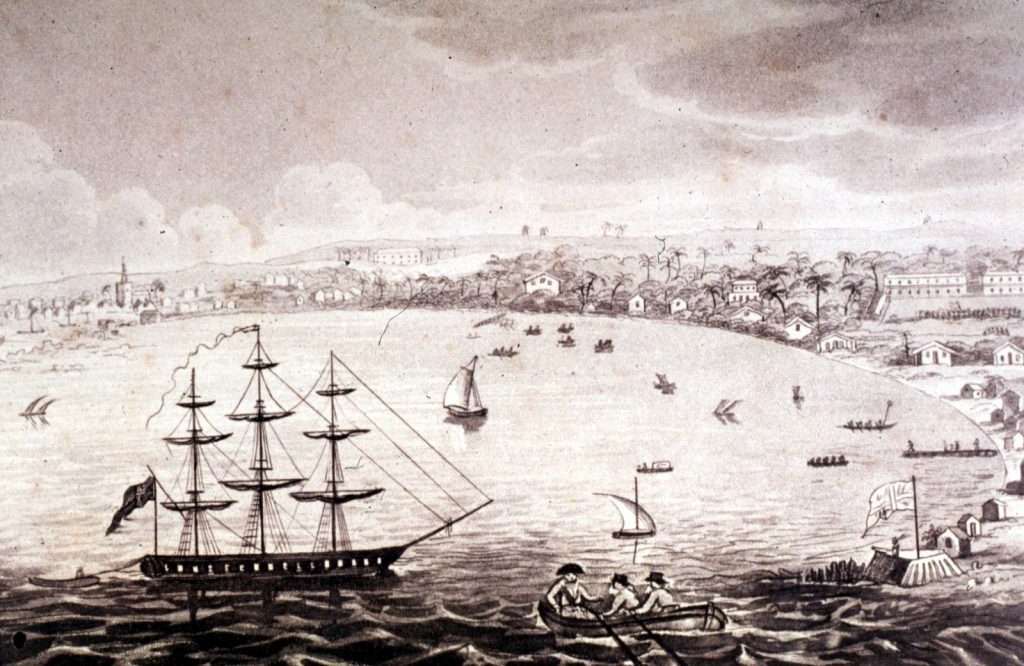 Carlisle
Bay and Bridgetown, Barbadoes
Carlisle
Bay and Bridgetown, Barbadoes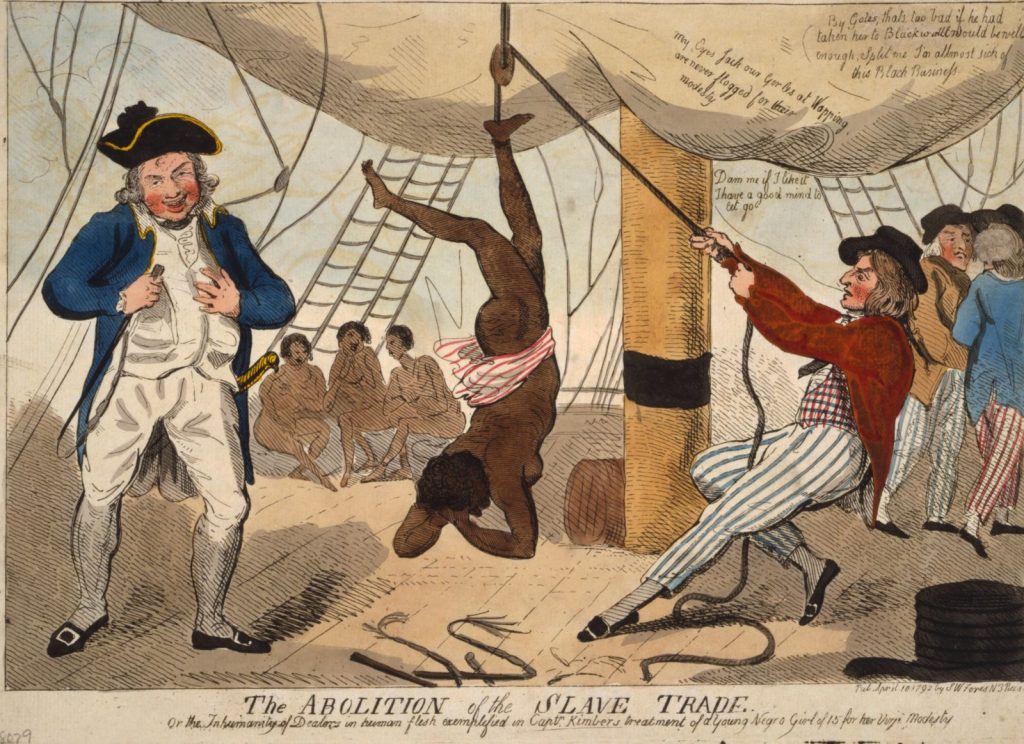 A
color print by Scottish cartoonist Isaac Cruickshank, captioned below: "The
abolition of the slave trade or inhumane human flesh dealers as exemplified by
Captain Kimber's treatment of a fifteen-year-old black woman for her virginal
modesty" shows John Kimber with a whip in his hand and an African girl suspended
by her ankle from a rope above a pulley. The drawing reflects a
well-documented episode of the British campaign against the slave trade. John
Kimber was the captain of the slave ship Recovery, owned by Bristol merchants,
which sailed from New Calabar (modern Nigeria) to the West Indies in 1791. In
a speech before the House of Commons in 1792, William Wilberfoss, an
abolitionist leader, accused Kimber of beating a girl to death because she
refused to dance naked on the deck of his ship. As a result of
Wilberforce's speech, Kimber was arrested and brought before the Supreme Court
of the Admiralty in June 1792, where he was also charged with the murder of
another girl on his ship. The jury acquitted Kimber of all charges,
stating that the cause of the girls' deaths was illness, not abuse.
A
color print by Scottish cartoonist Isaac Cruickshank, captioned below: "The
abolition of the slave trade or inhumane human flesh dealers as exemplified by
Captain Kimber's treatment of a fifteen-year-old black woman for her virginal
modesty" shows John Kimber with a whip in his hand and an African girl suspended
by her ankle from a rope above a pulley. The drawing reflects a
well-documented episode of the British campaign against the slave trade. John
Kimber was the captain of the slave ship Recovery, owned by Bristol merchants,
which sailed from New Calabar (modern Nigeria) to the West Indies in 1791. In
a speech before the House of Commons in 1792, William Wilberfoss, an
abolitionist leader, accused Kimber of beating a girl to death because she
refused to dance naked on the deck of his ship. As a result of
Wilberforce's speech, Kimber was arrested and brought before the Supreme Court
of the Admiralty in June 1792, where he was also charged with the murder of
another girl on his ship. The jury acquitted Kimber of all charges,
stating that the cause of the girls' deaths was illness, not abuse.
Prosperous plantations became the main
source of sugar for England. In 1680, the metropolis exported 10
thousand tons of sugar from the island - 60% of all sugar imports. The
plantations received favorable loans and the goods they needed.
Sugar, grown almost entirely by enslaved
Africans in the Caribbean, became an integral part of the diet of the people of
Britain in the 17th and 18th centuries. Protective duties on sugar
in the West Indies meant that these plantations had a virtual monopoly on the
British domestic sugar market. This state of affairs continued
until 1834, when slavery was abolished.
Planters have learned to ferment and
distill cane juice and the foam removed during the boiling process. The
resulting alcoholic drink was called cane brandy. This process was
subsequently improved - brandy was made from molasses, a by-product of sugar
production. The resulting drink, known as "devil's killer", was
strong but not very palatable. Importing wine and beer was too
expensive, and besides, these drinks could spoil during transit from Europe, but
the "devil's killer" could be produced locally in any quantities. In
England, the drink was called Rumbullion, which means "big noise". Since
1661, the drink that has spread throughout the islands of the Caribbean began to
be called simply Rum.
Rum became a popular drink for sailors
and, from 1655, replaced beer in the traditional diet of the British Royal Navy
in the Caribbean. However, replacing a gallon of perishable weak
beer with half a pint of rum had predictable consequences and prompted Admiral
Edward Vernon to first issue an order to mix rum with two pints of water in
order to maintain discipline on ships, and then to add sugar and lime juice to
this mixture. This primitive cocktail was named grog after him. The
fact is that the sailors awarded the admiral the nickname Old Grogram because
Vernon never parted with a raincoat made of waterproof grogram fabric.
The replacement of beer by grog played a pivotal role in establishing British supremacy at sea during the 18th century. One of the main causes of death among sailors at that time was scurvy, a disease caused by a lack of vitamin C. Lemon or lime juice, an essential ingredient in grog since 1795, dramatically reduced the incidence of scurvy and literally healed British crews, unlike French sailors, whose diet included three-quarters of a liter of wine, and on long routes, three-sixteenths of a liter of brandy. Since wine contains a small amount of vitamin C, but brandy does not, this reduced the resistance of the French navy to scurvy, while the Royal Navy, according to one naval doctor, doubled its combat power.
Rum was given to newly arrived slaves for "taming", weeding out the weak and subjugating the disobedient. The performance of various unpleasant assignments was also rewarded with portions of rum. As a result, rum became an important tool of social control, and was also used as a currency to buy slaves.
According to an English trader, by 1721 rum had become the main barter on the slave coast of Africa, pushing even gold aside.
Unlike most other West Indian islands,
during the 17th century Barbados did not issue an official currency. The
basis of trade relations was barter, with some Spanish gold and silver.
During the 18th and early 19th centuries,
silver Spanish-American 8 reais (or the dollar) and Spanish 2 reales, the
pistareen, were used as currency in Barbados. To obtain small
denominations, the coins were cut into two, four or eight parts.
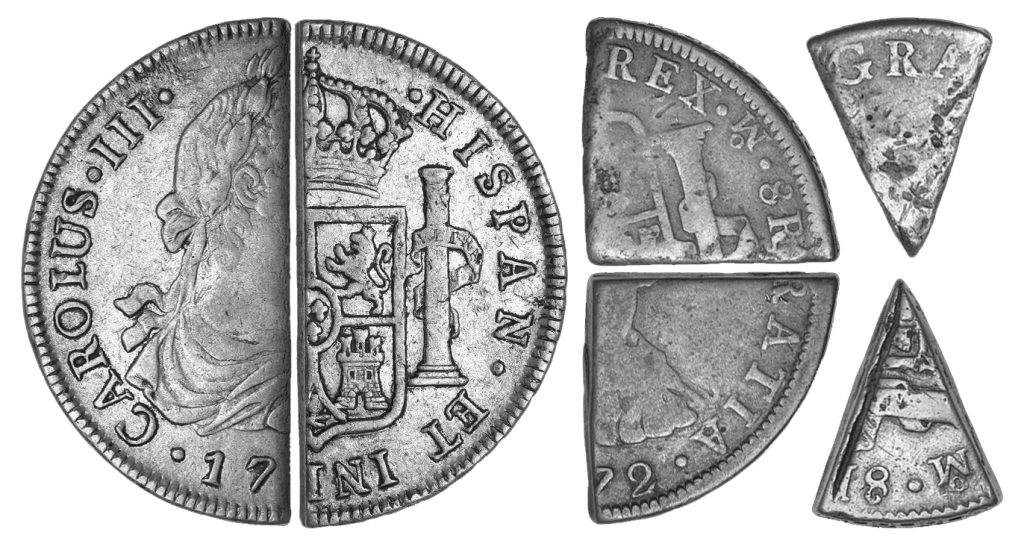
From 1704 to 1739, the dollar was used, which was valued at 8 bits or 6 shillings. During this period, the dollar was cut into two, four or eight parts to get 4, 2 or 1 bit, which was equal to 9 pence.
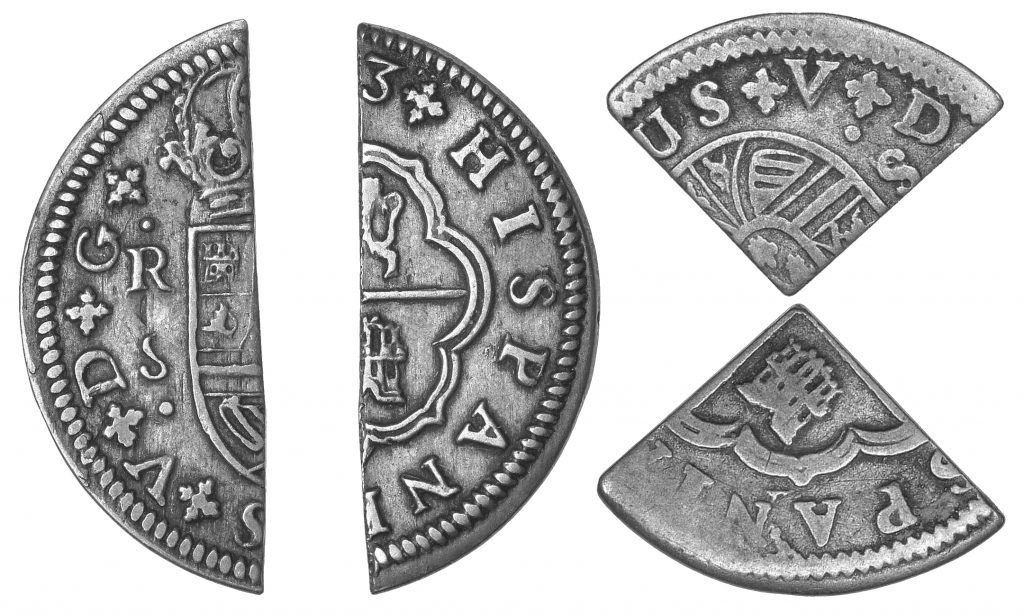
From 1740 to 1799, the main coin was pistarin, which was equal to two bits or one shilling and three pence, and half and a quarter was equal to 1 and ½ bits, respectively. During this period, the value of the dollar increased and was equal to 10 bits or 6 shillings and three pence.
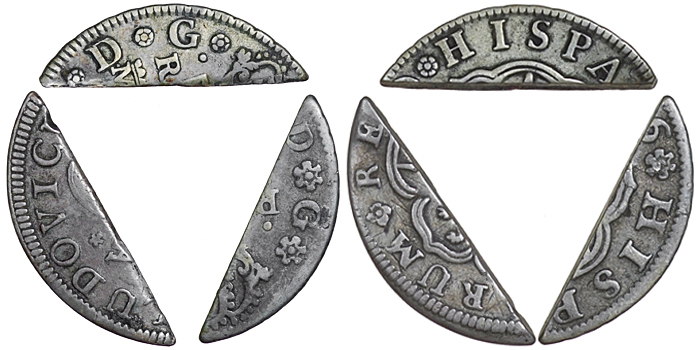
In 1789, smaller lightweight segments appeared in circulation, issued for 1 bit - Birmingham counterfeiters cut the pistarine with a triangular-shaped mechanical tool, receiving three side segments, and the central part of the coin, equal in weight to three segments, was sent for remelting.
From 1789 to 1799, attempts were made to regulate the circulation of a cut coin, but only on March 19, 1799, the first law was adopted, according to which cut coins cease to be a means of payment, and instead it was proposed to use whole coins.
In some cases, even 1/8 of the pistarin was a large denomination and there was a need for a smaller coin. In 1788, penny-denominated copper tokens known as "Pineapple" were issued in England. It is believed that the local owner of the sugar plantation Philip Gibbs was the customer for the production of tokens.
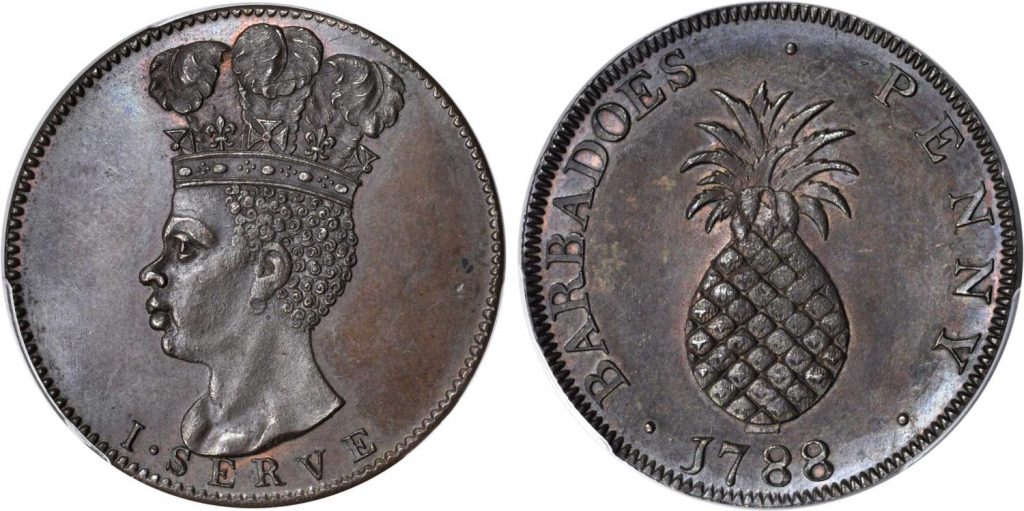
The obverse depicts the national symbol - pineapple and the legend: “Barbadoes Penny”, at the bottom of the date 1788. The reverse shows the bust of an African, whose head is decorated with feathers and the legend “I serve” (I serve). Stamps have varieties in size of pineapple and head.
The proud-looking African actually symbolizes a slave subject to European colonization in the person of the British King George III, as satirically evidenced by the crown of the Prince of Wales on his head.
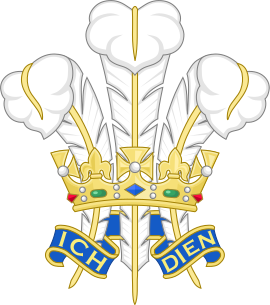 The
heraldic badge of the Prince of Wales consists of three white ostrich feathers
emerging from a golden crown. On the ribbon under the crown, the
motto: ICH DIEN (German: I serve)
The
heraldic badge of the Prince of Wales consists of three white ostrich feathers
emerging from a golden crown. On the ribbon under the crown, the
motto: ICH DIEN (German: I serve)The stamp engraver was John Milton, who in 1789 became assistant engraver at the Royal Mint. The issue of tokens took place on October 4, 1788 by Hancook in Birmingham, in the amount of 5,376 pieces, each weighing half an ounce. Some of them have been released as Proof for sale to collectors.
Philip Gibbs was born in the parish of Saint James in Barbados on March 7, 1731. Before taking over his father's sugar plantations in Barbados, Philip studied law in London. In 1753, he married Agnes Osborne, the only heiress of the Barbados planter of English origin, Samuel Osborne, at St. James's Church. They had four children who were brought up in England, while Philip was focused on his political and financial affairs in Barbados, London and Bristol.
Gibbs was appointed to the Barbados legislature and provided legal advice to the governor of the island in Bridgetown. On May 30, 1774, he received the status of Baronet. In 1777-78, Gibbs met with Franklin and the British Prime Minister as a self-promoting mediator at the head of a group representing the interests of Caribbean plantation owners. He was a member of the Barbadian Society for the Improvement of Plantership and was a co-author of publications on plantation management and the treatment of Negroes.
From 1798 to 1815 Gibbs rented a townhouse on 4th New Burlington Street. By old age, his health deteriorated and he lost his sight. He died at Springhead House on June 27, 1815, while under the care of a plantation manager, and was buried on the grounds of St. James Church, Barbados.
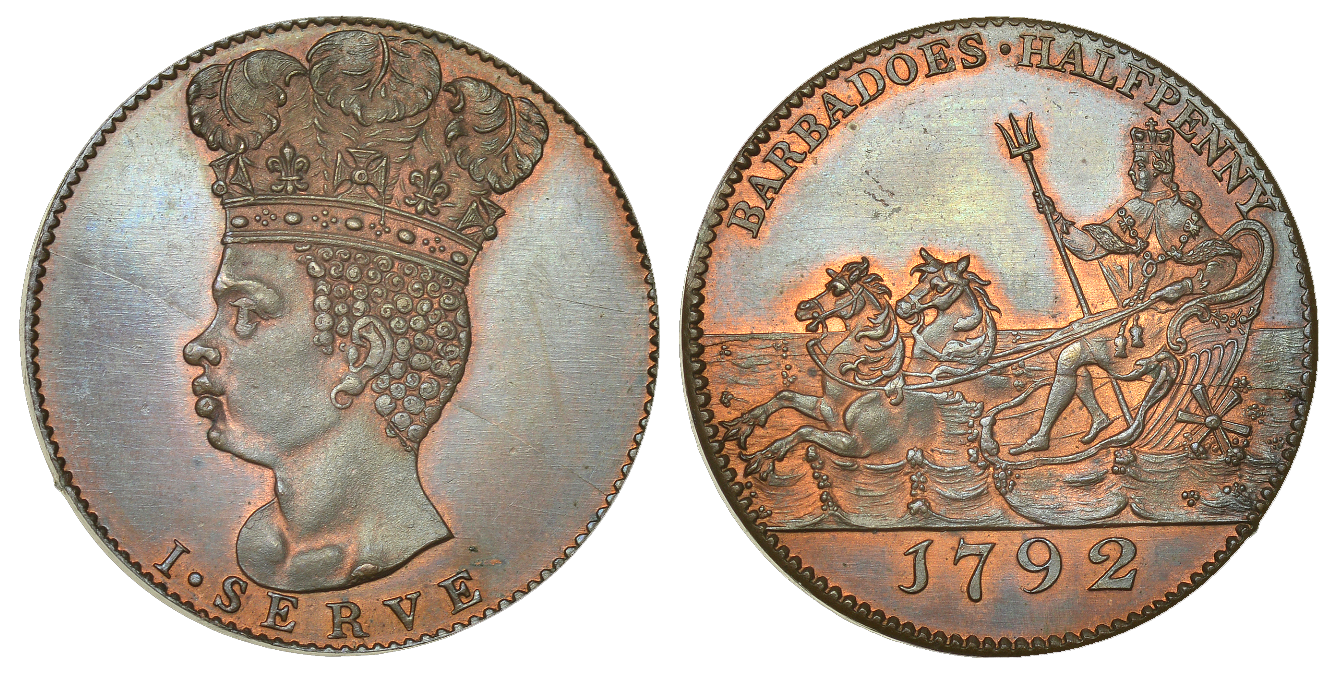
In 1791, allegedly John Arno, owner of the John Arnot and Co bakeries in Bridgetown, ordered the production of new tokens in denominations of pennies and halfpenny. A total of 39,000 pennies and 46,800 halfpennies were issued. The obverse depicts King George III as Neptune riding a chariot drawn by a mythological hippocampus - a sea horse with a fish tail, in the upper part of the legend: "BARBADOES HALFPENNY" or "BARBADOES PENNY" and the date below 1792.
The image comes from the Great Colonial Seal, which was introduced by Charles II in 1663, 36 years after the first British settlements were established in Barbados.
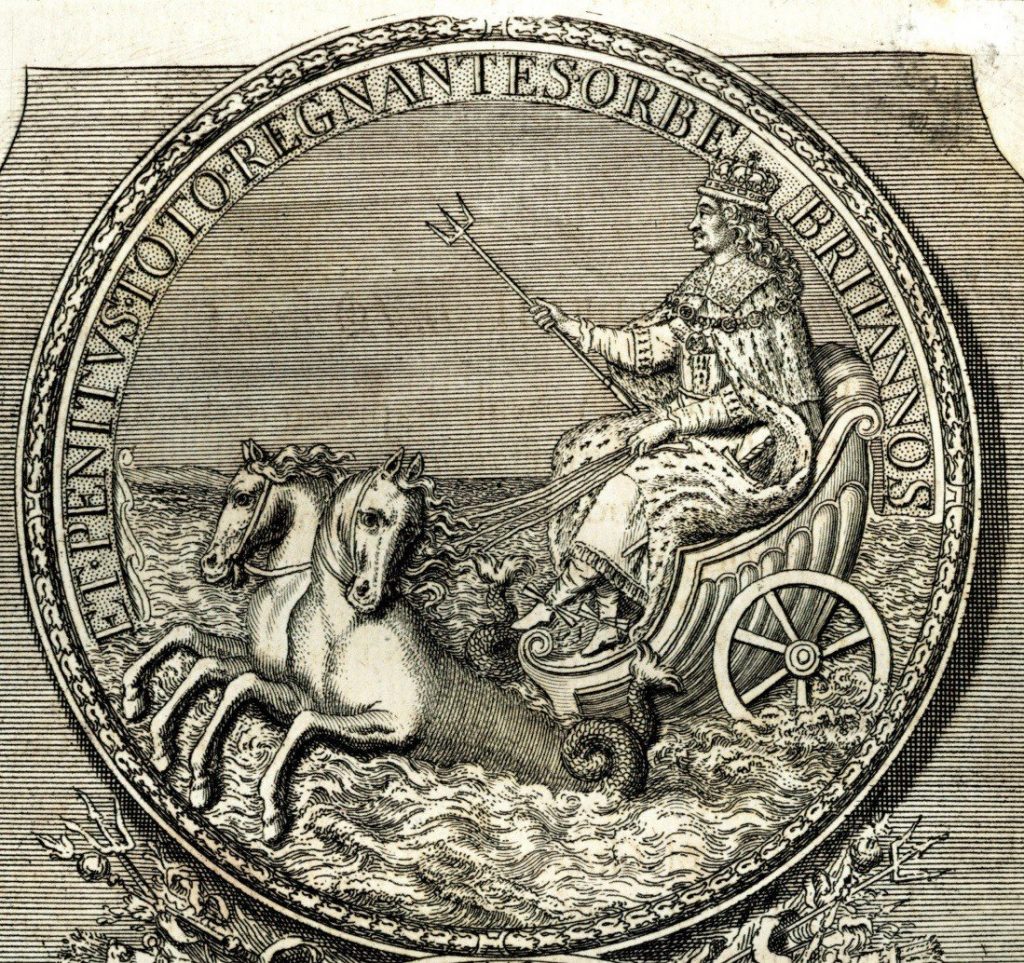 After
the restoration of Charles II, the Great Colonial Seal was made for the
colonies, for use by commissioners in the Admiralty. The seal
expressed the sovereignty of the king in the British seas. It
depicts the crowned Charles II in the form of Neptune, riding on the sea in a
chariot drawn by two sea horses. Legend at the top: “ET PENITVS
TOTO REGNANTES ORBE BRITANNOS”. The engraver of the seal was the
famous medalist and engraver of coins and seals, Thomas Simon (Thomas Simon
(1618-1665).
After
the restoration of Charles II, the Great Colonial Seal was made for the
colonies, for use by commissioners in the Admiralty. The seal
expressed the sovereignty of the king in the British seas. It
depicts the crowned Charles II in the form of Neptune, riding on the sea in a
chariot drawn by two sea horses. Legend at the top: “ET PENITVS
TOTO REGNANTES ORBE BRITANNOS”. The engraver of the seal was the
famous medalist and engraver of coins and seals, Thomas Simon (Thomas Simon
(1618-1665).The reverse repeats the image of the bust of an African issued in 1788. The tokens were widely circulated throughout the island, although they were privately issued without the status of legal tender in the British Empire.
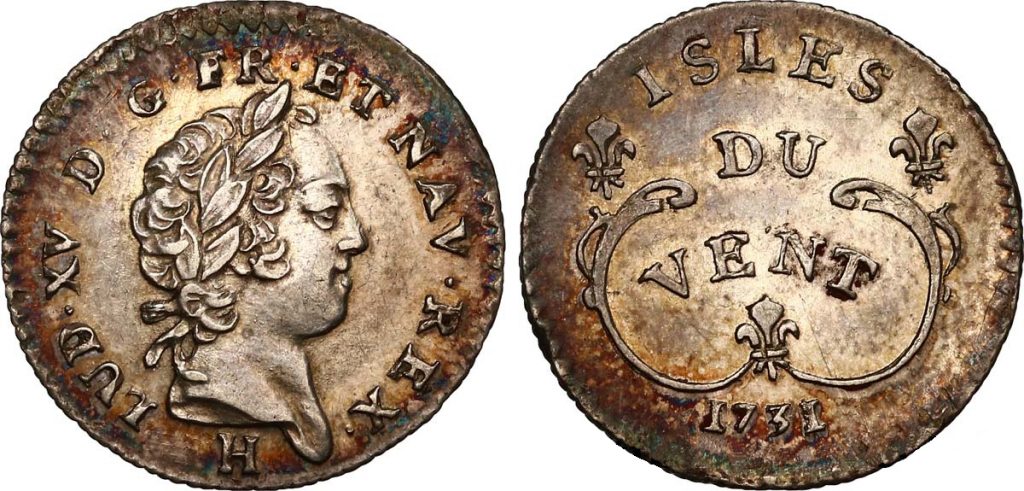 12
soles 1731 French windward islands
12
soles 1731 French windward islandsDespite the terms of the law passed in 1799, cut ½ bitts appeared in circulation, obtained from half the Spanish real or 12 soles of 1731 of the French windward islands, which were circulated by agreement. The ¼ pistarine segments also continued to circulate for several years after 1799 and were equal to ½ bitt or 3 ¾ pence.
In 1822, the British government issued a series of silver coins in denominations of 1/16, 1/8, 1/4 and 1/2 dollars from the Anchor Coins series, for use in the British colonies of Canada and the West Indies.
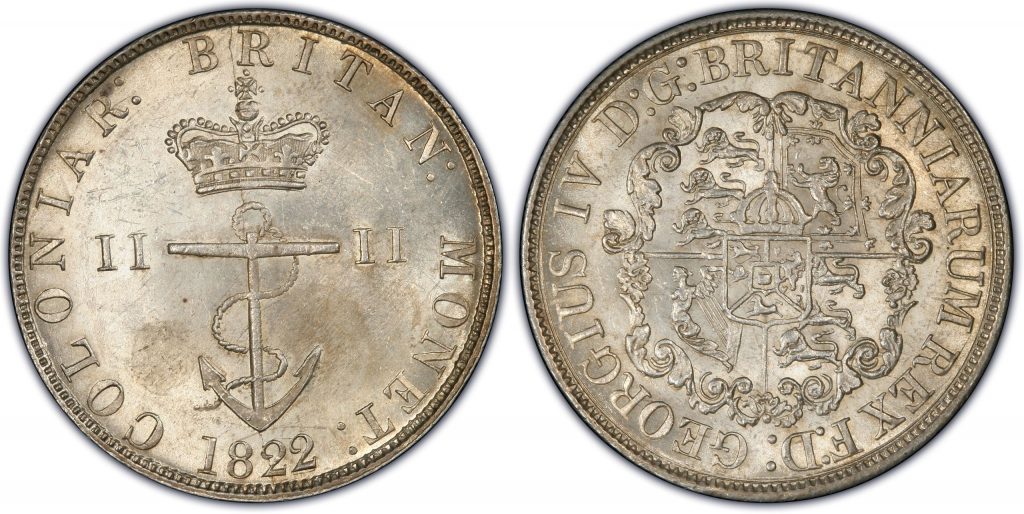 1/2
dollar 1822
1/2
dollar 1822Since 1825, British pounds, shillings and pence have also been used in Barbados and the rest of the West Indies. By 1838, when they began to carry out currency reforms, the cut coin completely disappeared from circulation.
On August 21, 1848, a local law was passed establishing British coins as the currency of Barbados, and on February 17, 1868, a law was passed establishing liability for damage to coins. Section 16 of the Act stated: " Whoever defaces any of the Queen's gold, silver, or copper coins by stamping upon them or any names or words, or by reducing the weight of the coin, shall be found guilty and sentenced therefor to imprisonment for a term of one a year with hard labor or without it, at the discretion of the court . This law was copied from the Imperial Crimes Act of 1861, which was reissued with some modifications by most of the colonies.
In the second half of the 18th century, blacks freed from slavery (freedman and freedwoman) began to appear in Barbados. As a rule, these were children born from the owner of the plantation and his slaves.
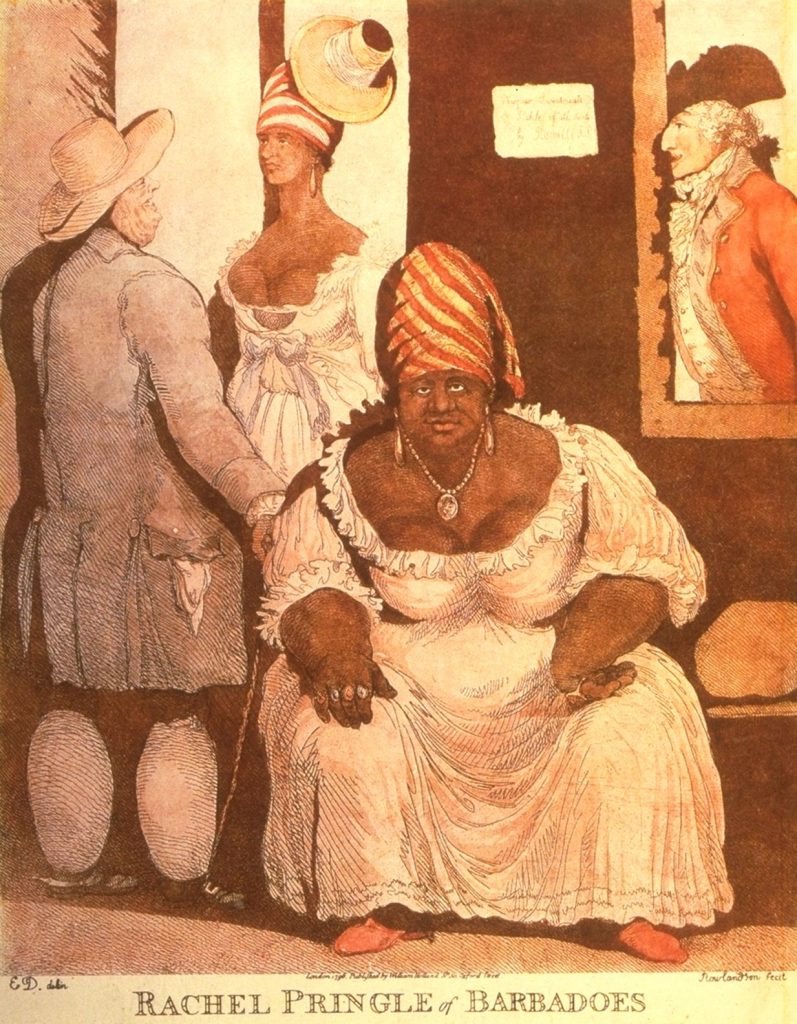 Thomas
Rowlandson's illustration "Rachel Pringle, Barbados", published by William
Holland. (Rachel Pringle, Barbados, 1796, Thomas Rowlandson,
published separately by William Holland (London, 1796). The illustration shows
Rachel Pringle, aged about 36, sitting in front of a tavern in Bridgetown. The
white man on the left has elephantiasis, a manifestation of filariasis, a common
disease in West Africa during the slave trade era.In Barbados, the disease
mainly affected blacks, but sometimes found among the white population.Born
Thomas
Rowlandson's illustration "Rachel Pringle, Barbados", published by William
Holland. (Rachel Pringle, Barbados, 1796, Thomas Rowlandson,
published separately by William Holland (London, 1796). The illustration shows
Rachel Pringle, aged about 36, sitting in front of a tavern in Bridgetown. The
white man on the left has elephantiasis, a manifestation of filariasis, a common
disease in West Africa during the slave trade era.In Barbados, the disease
mainly affected blacks, but sometimes found among the white population.Born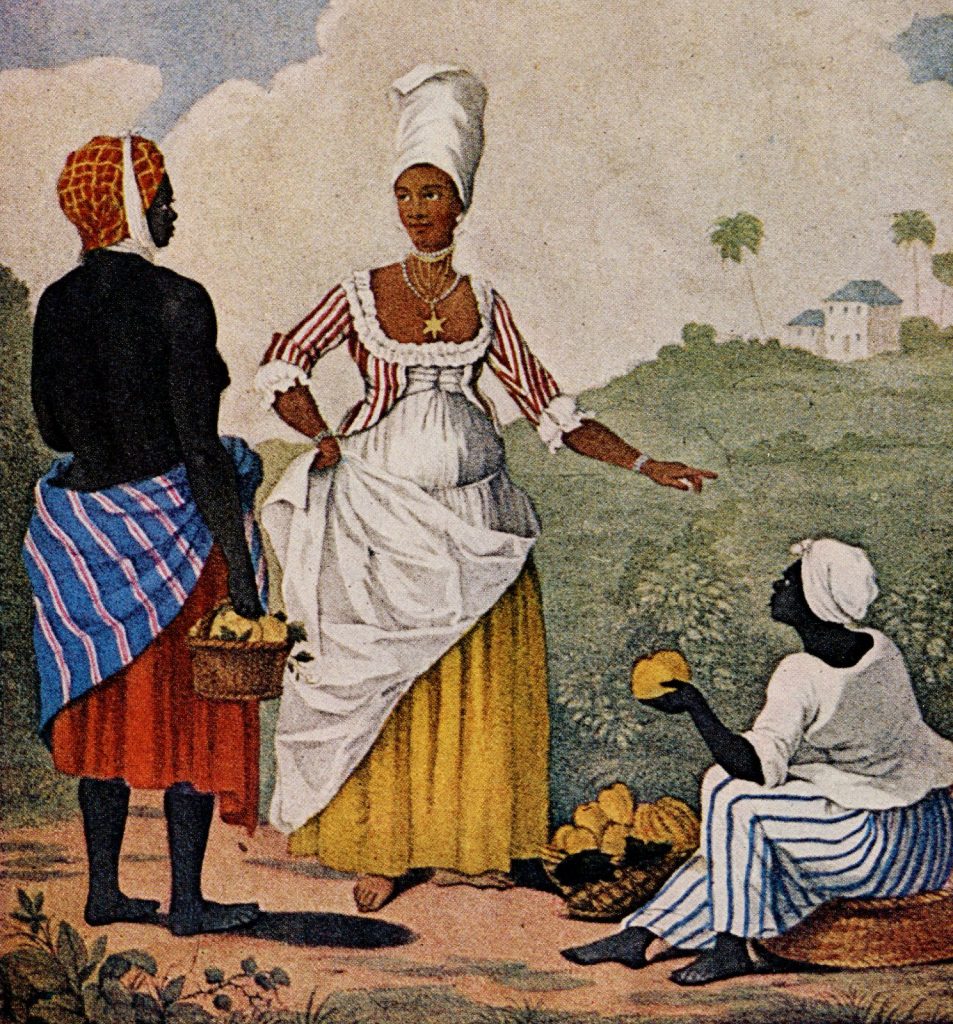 The
Barbadoes Mulatto Girl, Agostino Brunias, late 1770s.
The
Barbadoes Mulatto Girl, Agostino Brunias, late 1770s.Increasing British general public awareness of slave labor in sugar production led to a series of national boycotts in the late 18th century. The Manchester Anti-Slavery Women's Society was formed, producing pamphlets calling for sugar consumption to be reduced and to be bought from South Asia, where slave labor was not used for production.
The harsh conditions of plantation slavery and the life of "white servants" caused numerous riots and uprisings in 1649, 1685, 1692, 1702 and 1812. In 1805, the island was almost captured by the French.
In 1807 Great Britain abolished the slave trade, and in 1833 the British Parliament approved a bill to abolish slavery in the colonies. The planters received generous compensation, and the former slaves turned, in essence, into serfs, who received their freedom only in 1838. However, the majority of the rural population continued to work on the sugar plantations. The number of ex-slaves who began to rent land on the basis of a system of working off increased from 1,110 in 1844 to 3,537 in 1859. Large owners provided part of their land, and sometimes agricultural equipment, to small tenants on the condition that they grow and process sugar cane. At the end of the year, the sharecroppers paid the landowners in kind more than half of their produce.
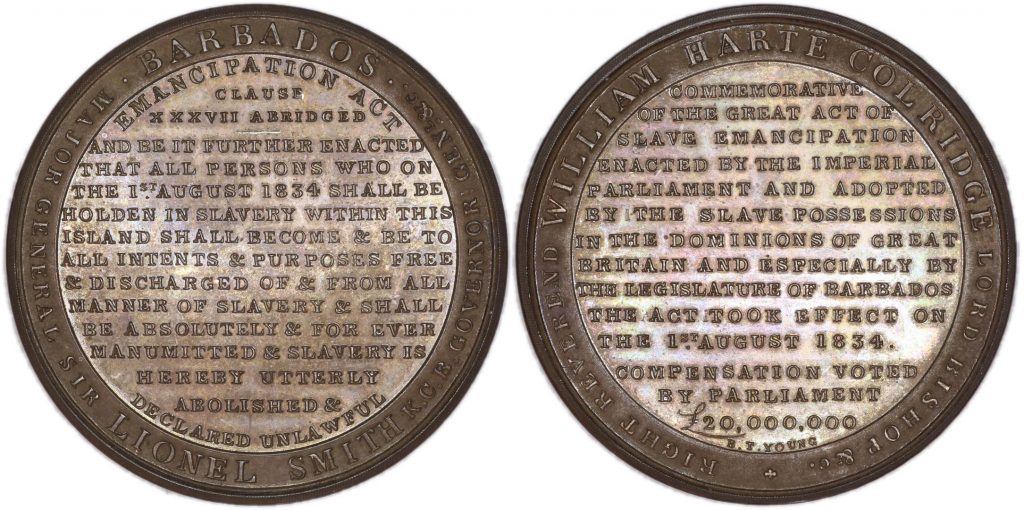
In 1834, Moses Tolano, a Sephardic merchant who had a shop at 33 Swan Street in Bridgetown, commissioned the production of undated farthings and halfpennies.
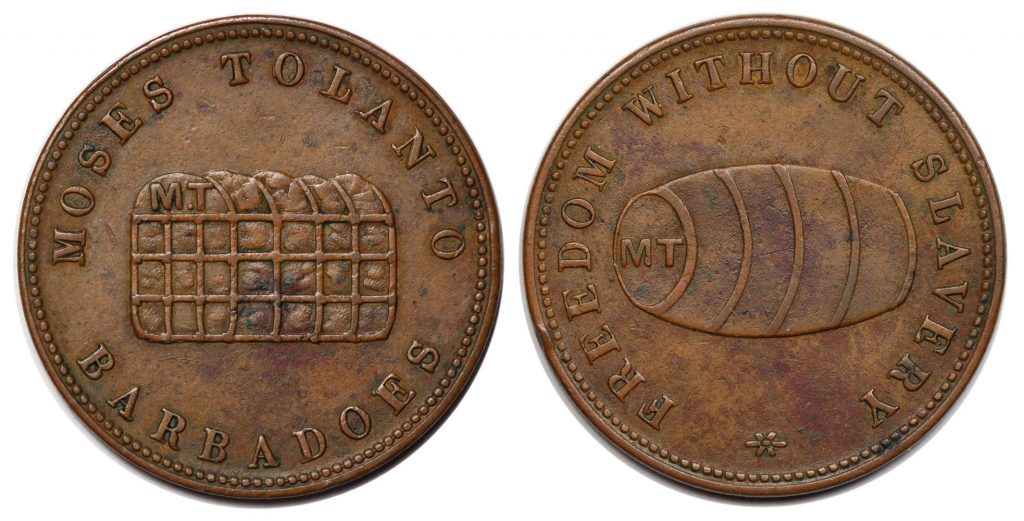
The obverse depicts a bale with the
initials MT and a circular inscription: MOSES TOLANTO BARBADOES.
The reverse shows a barrel with the
initials MT and a circular inscription: FREEDOM WITHOUT SLAVERY (Freedom without
slavery).
In the same year, Israel Bowen (1802-1880) founded a printing business in Bridgetown, opened a stationery shop on Church Street and, as an advertisement for his business, stamped a 1797 penny with a stamp “T. BOWEN BOOKSELLER & STATIONER BARBADOES. The letter "T" instead of "I" was used by mistake.
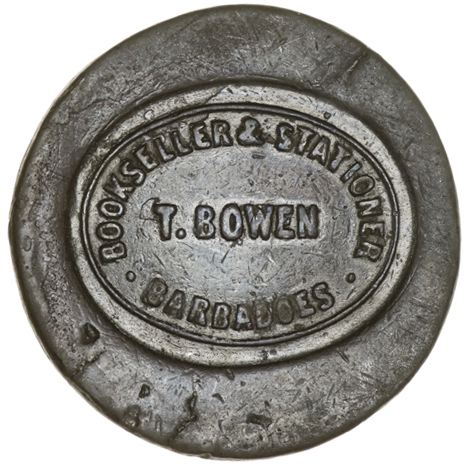
In 1841, the business moved to Trafalgar Street 13, and by 1863 to Broad Street 20 (Broad street). Since 1866, under the banner of Bowen & Sons, Israel's business was continued by his sons.
In 1850, Thomas Lawlor produced unofficial copper and brass farthings.
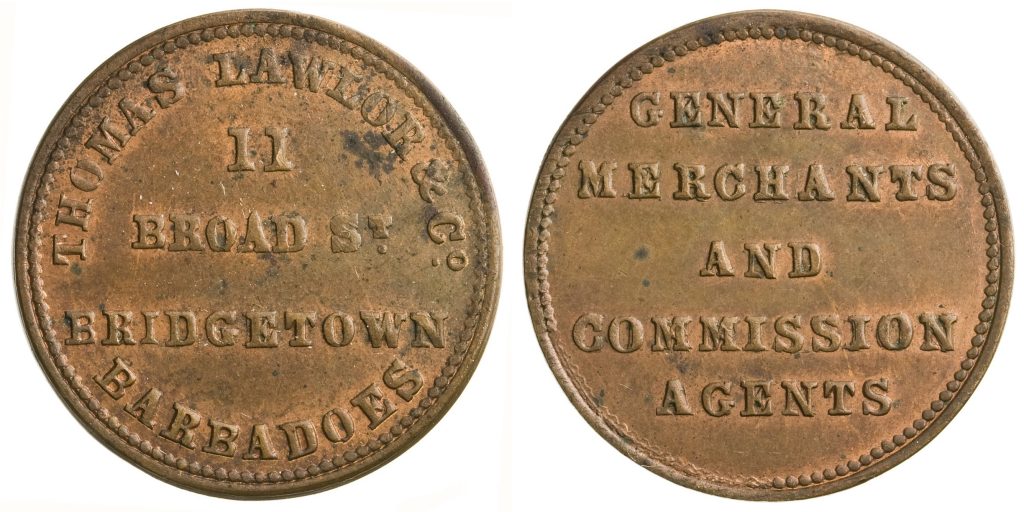
Thomas Lawlor & Co was founded in 1841 in Cork, Ireland. In 1847 a branch was opened in Bridgetown on Broad Street.
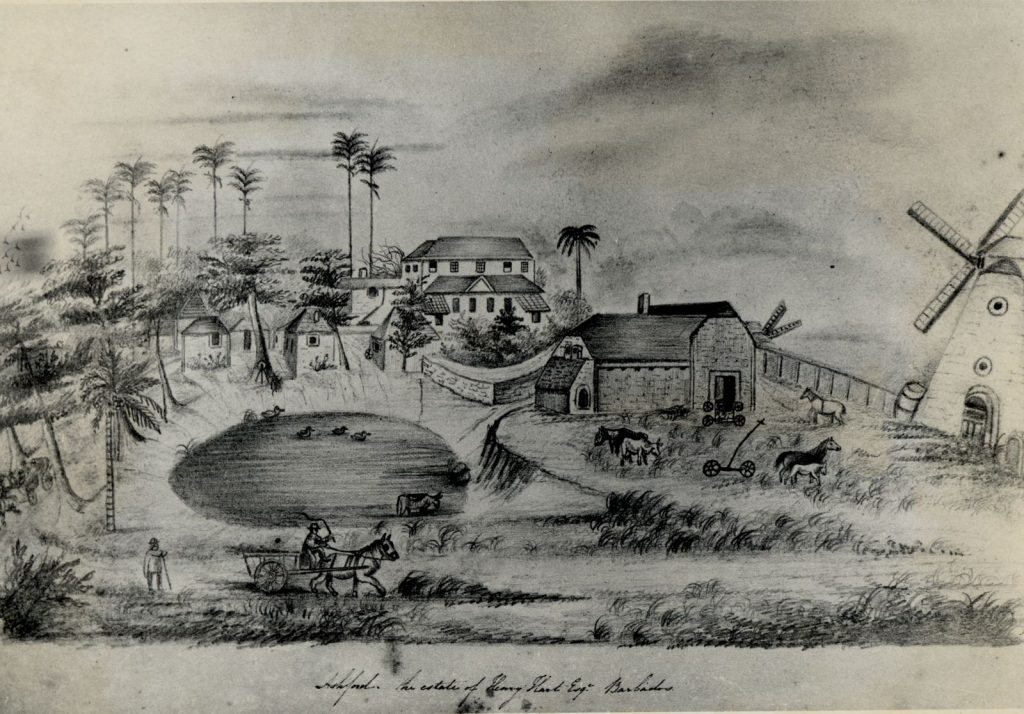 Ashford
the estate of Henry Hart Esq. Barbados
Ashford
the estate of Henry Hart Esq. BarbadosIn 1846, Great Britain abolished protective duties on sugar, which caused a severe crisis in the plantation economy, unemployment and famine. Discontent resulted in a powerful uprising in 1876. Its participants protested against the plan to unite the island administratively with other British colonies in the West Indies. They put forward the idea of a federation of Barbados and the adjacent islands. The speech was suppressed, but the plan to subjugate Barbados to other colonies was canceled in 1883. In 1885, the island was finally separated from other British possessions and made into a separate crown colony of Great Britain.
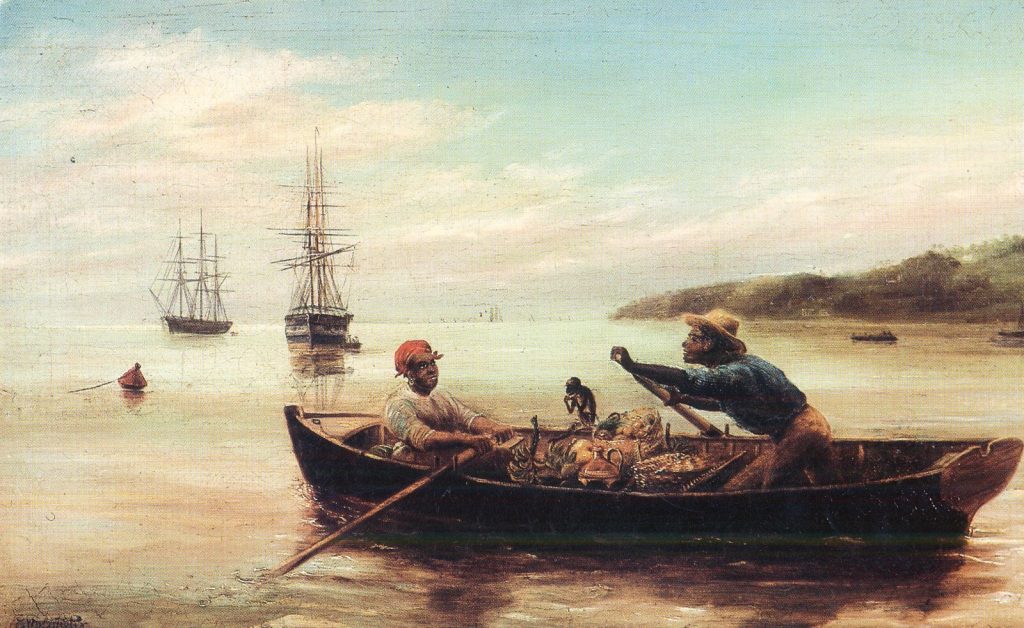 Bum
Boat in Carlisle Bay, Edwin Roper Loftus Stocqueler
Bum
Boat in Carlisle Bay, Edwin Roper Loftus StocquelerAt the end of the 19th century, people of African descent also received voting rights, but a rigid property qualification remained. From the middle of the 19th century, the emigration of the inhabitants of Barbados began in search of work to other islands of the West Indies, to build the Panama Canal, and later to the USA and Great Britain. At the beginning of the 20th century, there was a revival of the sugar industry, thanks to the improvement of sugar production technology. In 1928, about two-thirds of the island's population depended on its production. At the same time, three-quarters of peasant farms in the 1930s owned plots of less than one acre. The wages of agricultural workers remained very low: in 1930 they received 30 cents an hour.
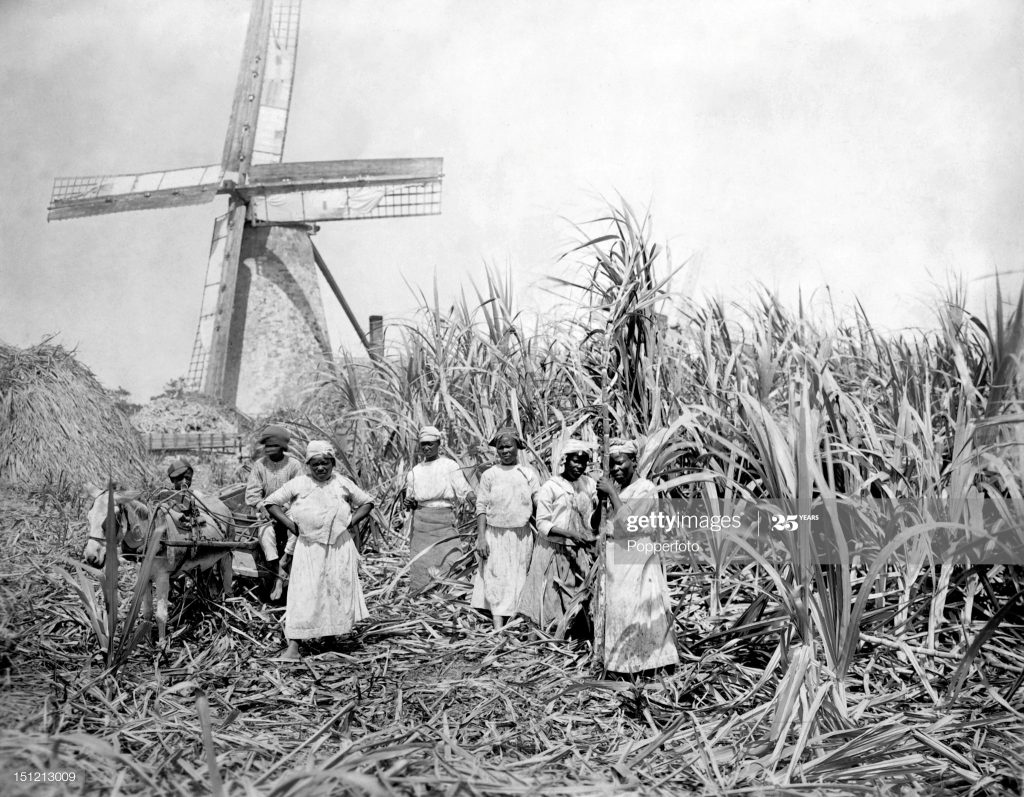 Sugar
cane plantation with field workers, Barbados, 1910
Sugar
cane plantation with field workers, Barbados, 1910After the First World War, the right to vote was granted to a wider section of the population. Official permission to create trade union and political organizations followed a major strike of workers and unrest in 1937 (despite their suppression). In 1938, the first political parties appeared. The largest of these was the Barbados Labor Party (BLP). In 1943, a welfare agency was established on the island. In 1944, women got the right to vote. Finally, in 1948, Barbados received limited internal self-government, and in February 1951, universal suffrage was introduced. On February 1, 1953, a responsible government headed by the prime minister was established on the island. The post was taken by BLP leader Grantley Adams.
In 1958, the British authorities
incorporated Barbados into the West Indies Federation. The
government of the federation was headed by G. Adams, the government of Barbados
- by Hugh Gordon Cummins. In 1961, Barbados received internal
self-government. The 1961 parliamentary elections were won by the
opposition Democratic Labor Party (DLP), which broke away from the BLP in 1955. She
won 14 out of 24 seats in the House of Assembly. Errol Barrow,
leader of the DLP, became prime minister.
The DLP government opposed the West
Indies Federation, and in 1962 it collapsed. Attempts to create an
Eastern Caribbean Federation instead of it were unsuccessful due to the position
of Barbados. At the annual meeting of the DLP in September 1965, at
the suggestion of Barrow, a resolution was adopted to grant the country full
independence; the idea of independence within a federation was
rejected. The House of Assembly then passed a resolution demanding
the independence of the island. In June - July 1966, a
constitutional conference was held in London, at which the British government
agreed to the independence of Barbados. Barrow stated that he
opposed US unilateral actions in the Western Hemisphere and intended to maintain
friendly relations with all countries, including the USSR.
November 30, 1966 Barbados was proclaimed an independent state.
Pridmore, Fred. The Coins of the British Commonwealth of Nations, Part 3,
West Indies, 1965
Tom Standage. A History of the World in 6 Glasses, 2009
The Barbados ‘Pineapple’ Pennies of 1788 by David Vice, Spink’s Numismatic
Circular, November 1977
Slaveryimages.org
BritishMuseum.org